This post is a work in progress. At the time that I published it, I hadn’t managed to identify any of the men in the photo. A resourceful reader in the UK, Michael, quickly identified two of them. The man seated in the middle of the second row is Frederic Thesiger, Viscount Chelmsford, who was Viceroy of India from 1916 until 1921. The man to the left of him, wearing a bow tie, is Alexander Muddiman.
Another astute reader in the UK, Val, identified the location as Gorton Castle in Shimla, Himachal Pradesh, India. Shimla (spelled Simla prior to 1972) was the summer capital of British India after 1864.
The photo came to me from Texas in 2020.



Post last updated July 7, 2022.

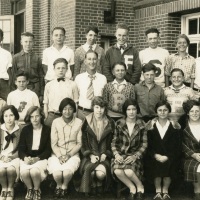



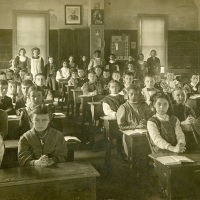

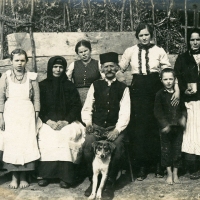
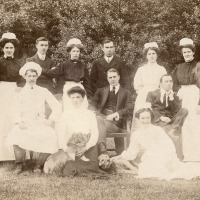
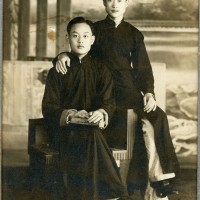
Some great faces there! No ideas here though sorry.
LikeLiked by 2 people
Thanks anyway, CJ!
LikeLiked by 1 person
Another mystery! They look so solemn. Could it be a graduating class of doctors?
LikeLiked by 1 person
It absolutely could. Or something more political. Darned if I know!
LikeLiked by 1 person
Great photo – they look like they could be part of a cast for “Around the world in 80 days” 😉 Of course they aren’t, but perhaps it’s why they look a bit familiar 🙂
LikeLiked by 3 people
Oh, that’s funny! With a diverse group such as this, it’s fun to try to figure out what brought them together. 🙂
LikeLiked by 1 person
Haha! Yes, very fun!
LikeLiked by 1 person
It’s clearly an international group. From the headgear, I’d guess at least one Sikh and a couple of fellows from some part of Africa. I’d guess some from south India, too. I wonder if it might have been some sort of theological conference — students from various seminaries. It’s a great photo – such detail!
LikeLiked by 1 person
The idea of a theological conference hadn’t occurred to me; it certainly has the feel of a conference. I suspect someone will know the answer. Thanks, Linda!
LikeLiked by 1 person
A wonderful photo, and very interesting. I hope you’ll find out more about this group!
LikeLiked by 2 people
Thank you, Linda! Someone will recognize one of these men for sure.
LikeLike
I was wondering if it might have been taken in India. I do like the idea of a theological conference, though!
LikeLiked by 3 people
Hi Liz, I don’t know enough about architecture in India or Pakistan to know if it could have been taken there. I did notice that the men are posed on an enormous rug, which I should have mentioned in the post.
LikeLiked by 1 person
Hi, Brad. I wasn’t sure about the architecture either. I did notice the rug at first, but then my eye glanced over it. I don’t think I’ve seen any other group portraits on a rug. Such an intriguing photo!
LikeLiked by 1 person
An international group for sure and not likely taken anywhere in Texas. Very interesting. What is the blue stuff?
LikeLiked by 2 people
I wondered if there were any buildings in Texas that looked like that! The blue shadows are caused by a chemical process called silvering or silver mirroring. It’s considered a defect in old photos, but I don’t mind it in small amounts. To my eye it’s like a patina.
LikeLiked by 1 person
My first thought was a medical school graduation. A mix of students and faculty. They all look so intelligent and solemn. Definitely an international group.
Hope someone provides the clue that allows you to unlock the history!
LikeLiked by 3 people
Maybe I should do some research into medical education in India before Partition. Thanks Becky!
LikeLike
A wonderful photograph, Brad! It would be a lot of effort to bring a rug of that size out of doors for a photograph. It must have been something very important to go to such trouble. All of them are impeccably dressed and are of varying ages. I’m very intrigued at what brought them together. The architecture of the building is beautiful. I wonder what the man in the window to the left is thinking. ☺️
>
LikeLiked by 1 person
Wow, great eye, Suzanne! I hadn’t noticed anyone in the window! I’ve cropped a close-up below. His presence makes me think the photo may been taken in India rather than the UK. The different ages in the group also intrigued me. The youngest members of the group are all seated on the ground, as befits their junior status.

LikeLiked by 1 person
Intriguing! I do hope you learn more. I’m no help at all.
LikeLiked by 2 people
Thanks Eilene!
LikeLiked by 1 person
Could it be a political conference? Is it something to do with the Ottoman Empire? If the latter, then the academics who run the Ottoman History Podcast maybe interested….
LikeLiked by 2 people
My first thought was that it might be political. I doubt any Ottoman connection, but I’m often wrong! Thanks for your comment. 🙂
LikeLiked by 1 person
Very nice group image, perhaps post WWI based on the presence of Homburg hats, which became more popular then. Multiple faiths, but no obvious priests or clergy, so I don’t think that religion is the reason for this conference.
I have no insight as to the location, but would not rule out the US. The central figure with the cane and the Homburg looks American to me.
I am hoping that they had a benevolent and enlightened discussion about….science ?
‘To be continued’ – do you have another image taken at the same location, that would be splendid
LikeLiked by 2 people
Hi Michael, so glad you chimed in! This was the photo I had in mind a while ago when I asked if you had any particular interest in photos from India. I think it probably is post-WWI, but I wasn’t sure. I know the British government was grateful for the support India provided during the war. I hadn’t thought to use the hats to help date the photo.
You think it could be American? I suppose it could have been taken at one of the older universities.
‘To be continued’ was a reference to the fact that I hoped to add to the post at a later date if information could be found. The only thing I can add is that the mount was cut down, which suggests to me that the photo may have been framed by its original owner.
LikeLike
On reflection – yes, India is more likely, and the architecture looks more colonial than a UK university.
Another suggestion – mathematicians.
LikeLiked by 1 person
Many possibilities here. It could have been taken in England. It could be an international program at a university. People training in theology as others mentioned, medical school, education, sciences engineering or even law, etc.
LikeLiked by 2 people
Brad, this is a significant photograph concerning the journey to Indian independence !
Thanks to a reverse image search on selected faces, I found that the man at centre left with the bow tie is Sir Alexander Muddiman. The man at centre (who I thought looked American..) is actually Frederic Thesiger, Viscount Chelmsford. He was Viceroy of India from 1916 until 1921.
Lord Chelmsford introduced the Montagu-Chelmsford reforms, giving some authority to ‘local’ Indial bodies. However he also enforced some repressive anti-nationalist and martial laws that culminated in the notorious Amritsar massacre in 1919.
Calls by the Indian National Congress for more autonomy led to the creation of the Muddiman Committe in 1924, which investigated the Constitution of 1921. Perhaps inevitably, the committee could not agree and the report was split along colonial and nationalist lines. Subsequently a Royal Commission was set up, none of this to the satisfaction of Ghandi or other prominent supporters of independence.
This may be a photo of the Muddiman Committee, but if so I am not sure why Lord Chelmsford would be present if this was taken in 1924 – he had moved back to the UK. Also Mohammad Ali Jinnah was a member, and I can’t place him in the photo. Perhaps it was taken at another consultative meeting in 1921, location uncertain.
Still plenty of room for more research, over to you!
LikeLiked by 3 people
Michael, this is very exciting! I didn’t think of trying a reverse-image search. (I haven’t tried one in years.) Now the fun begins! Since Frederic Thesiger was Viceroy of India from 1916 to 1921, the photo was almost certainly taken during that time. Alexander Muddiman may be the key to identifying the other men, if we can find out what he was doing during those years. I should probably post this photo to Facebook or someplace and ask for help, but I’ll see what I can find out first.
LikeLike
I’m not absolutely sure, but I think that Mohammad Ali Jinnah is the tall person behind the Viceroy. He used to have (in his younger years) this quite impressive moustache.
LikeLiked by 1 person
I can see the resemblance in this photo dated 1910 from Wikipedia. And he was a tall man at 5’10” (1.78 m). So yes, it could possibly be him. Thanks for your comment!

LikeLike
Those are serious mustaches!
LikeLiked by 2 people
Only the best. 😉
LikeLike
This is just a guess, but I would say that this is a colonial building (ie, built by the British) in India or what became Pakistan. It doesn’t look like a building in the UK – the mix of architectural styles in the brickwork, windows, archway, supports to the balconies, etc isn’t really the sort of thing we have here. I may be wrong, of course, but that’s my feeling. Also, I’d think it’s more likely to be a government building than a university. the lower windows have a particularly mundane style to them, apart from a little bit of leading and stained glass in their upper parts.
Through the archway, there seems to be a gate, rather than a door.
LikeLiked by 1 person
Hi Val! I’m less inclined now to think this was taken at a university, given the fact that at least two high-level government officials were present. And it was almost certainly taken in India, Pakistan or Bangladesh. Still so many questions… Thanks for your help!
LikeLiked by 1 person
I wonder if the man in the white or pale turban was P.S. Sivaswami Iyer. See this: https://en.wikipedia.org/wiki/P._S._Sivaswami_Iyer
LikeLike
Although there’s a resemblance, I think the man in my photo is younger. P.S. Sivaswami Iyer was born in 1864, which would put him in his fifties when the photo was likely taken.
LikeLiked by 1 person
I’ve found the building. It’s Gorton Castle in Shimla. So, definitely in India! There are a lot of photos (and videos) of it online. This site has some clickable pics and a video: https://www.tripopola.com/location/shimla/gorton-castle/16019#prettyPhoto%5Bgallery1%5D/1/
the third picture from the left seems to be the best. Apparently the building is currently used as the office of the Accountant General of Himachal Pradesh.
There are also a load of good photos of it on Google Maps.
So… possibly easier to find some more info now?
LikeLiked by 1 person
Great work, Val! Very exciting!
LikeLiked by 1 person
Thanks to Val’s identification of the building, I believe we can date this photograph to 1918 or 1919.
Gorton Castle was the Government of India Secretariat building, used every hot season when the government moved from Kolkata to the much more temperate Shimla.
The collected speeches of the Viceroy Lord Chelmsford were published in 1921 and are available at Archive.org. Between 1918 and 1920, he addressed the opening and closing sessions of the Imperial Legislative Council, some of which were held at Shimla.
If MA Jinnah is present in the photo, then it cannot be 1920. Jinnah was an elected member of the Council between 1910 – 11 and 1916-19. He resigned from the Council after the 1919 session passed the Rowlatt Act, which introduced detention and trial of ‘insurgents’ without the protection of law. Jinnah denounced this legislation as the ‘Black Act’ and the Council as ‘a machine propelled by the British Government’.
I can’t identify any other people in the photo. I suspect that they are a mixture of elected members and nominated officials, but someone must know !
LikeLiked by 2 people
Michael, your efforts are much appreciated! I’ve made some additional efforts to identify the men as well, so far without success. I’m not convinced that M.A. Jinnah is in the photo. In pictures of him taken later in life, he looks very different from the man in this photo. However, it’s helpful to know that he was a member of the Imperial Legislative Council through 1919. Thank you!
LikeLike
Wow – fantastic detective work here. The comments posted here really make the photo (and history) come alive.
I love the blue silvering effect.
LikeLiked by 1 person
Thanks Ruth! I like the silvering, too. I’m still making inquiries about this photo. I’ve also ordered a book of photographs of the Raj, published in 1977, which should come this week. The detective work continues!
LikeLiked by 1 person